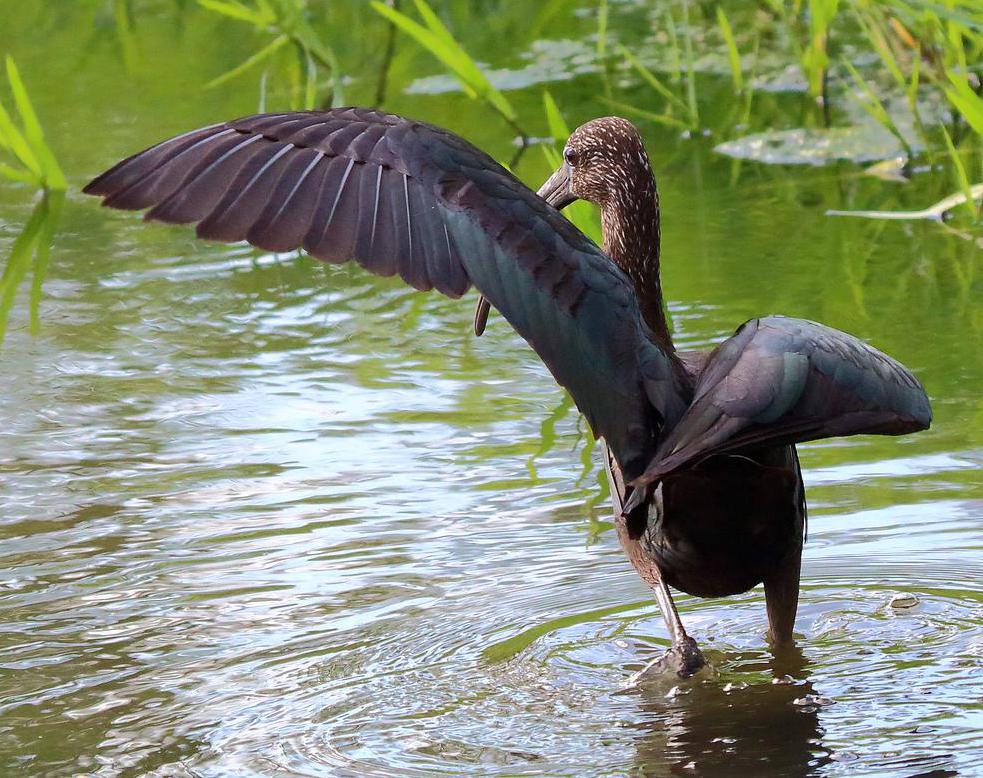At AllThingsNature, we're committed to delivering accurate, trustworthy information. Our expert-authored content is rigorously fact-checked and sourced from credible authorities. Discover how we uphold the highest standards in providing you with reliable knowledge.
What is a Glossy Ibis?
A glossy ibis is a dark-colored bird that has a long, curved beak and lives mainly in coastal areas and wetlands. It is known as Plegadis falcinellus within the scientific community. This type of bird often is called a shorebird in North America, and it sometimes is called a wading bird.
An adult glossy ibis usually is about 20 to 25 inches (51 to 64 cm) tall, and its wingspan is about 3 feet (92 cm) across. It has an oval body and a long neck, long legs and a long, curved beak. The glossy ibis has a dark, brick red head, neck and chest, and its back, wings and tail are a shiny, glossy green. Its beak and legs are dark brown or gray. Young birds that haven't fully matured have similar coloring, but it is muted.

The glossy ibis lives in coastal areas and wetlands. Its preferred habitat includes swamps, marshlands and flooded fields near wooded areas. It can be found all over the world in the warmer areas of Europe, Asia, Africa, North and South America and Australia. In North America during the warmer months, it can be found all along the eastern coast and along parts of the Gulf coast, an area spanning from Maine to Texas. During the winter, the bird migrates and can be found south of South Carolina.

The glossy ibis has an extremely varied diet. It eats a variety of food, such as seeds, insects, crayfish, small fish, frogs, small snakes and different types of worms. Walking slowly through an area, the glossy ibis hunts for food by using its long beak to poke around in the mud and underwater plant growth, feeling for food. It usually will hunt and feed in small groups with other wading birds.

Pairs of glossy ibises stay together and mate during the breeding season. Working together, the male and female build a tightly woven, round nest. The nest usually is built in a low tree, a bush or occasionally on the ground in dense brush. Often, the glossy ibis will build nests in a common area with other water birds, such as herons, as well as other ibises. After the nest is built, the female ibis lays three to four blue-green eggs.
Both male and female ibises incubate the eggs for about three weeks. After the eggs hatch, the baby chicks are helpless for a while. They are cared for by both parents, who feed them by regurgitating food for them into their beaks. After about a month, the chicks are able to start leaving the nest. By the time they are about 2 months old, the young ibises are able to go with their parents to hunt for food and become independent.
Frequently Asked Questions
What is a Glossy Ibis and where can it be found?
The Glossy Ibis is a wading bird known for its iridescent plumage, which appears dark with a sheen of green and purple in the light. It inhabits wetlands across the world, including parts of Europe, Africa, Asia, Australia, and the Americas. They are often found in marshes, swamps, and near rivers, where they forage for food.
What does the Glossy Ibis eat?
Glossy Ibises have a diverse diet that primarily consists of aquatic prey. They feed on insects, small fish, frogs, and crustaceans, which they find by probing in mud with their long, curved bills. Their foraging behavior is a fascinating adaptation to their wetland habitats, allowing them to sense and capture food beneath the surface.
How does the Glossy Ibis reproduce?
Glossy Ibises are colonial nesters, often breeding in large groups. They build their nests from reeds and sticks in trees or shrubs near water. A female typically lays between 3 to 4 eggs, and both parents share incubation duties for about 21 days. The chicks are then cared for by both parents until they fledge.
Is the Glossy Ibis considered an endangered species?
Currently, the Glossy Ibis is not considered endangered. According to the International Union for Conservation of Nature (IUCN), it is listed as a species of Least Concern. However, they are subject to habitat loss and degradation, which could impact their populations in the future, emphasizing the need for ongoing conservation efforts.
How can one identify a Glossy Ibis?
To identify a Glossy Ibis, look for a bird with a long, down-curved bill and a slender body. Its feathers are generally dark, but in good lighting, they exhibit a stunning glossy sheen with shades of green, purple, and bronze. In flight, their long legs extend beyond the tail, and they fly with neck and legs outstretched.
What is the significance of the Glossy Ibis in its ecosystem?
The Glossy Ibis plays a crucial role in its ecosystem as both a predator and a prey species. By feeding on various invertebrates and small vertebrates, it helps control pest populations. Additionally, as a prey species, it supports higher predators. Its presence indicates a healthy wetland ecosystem, which is vital for biodiversity and water purification.
AS FEATURED ON:
AS FEATURED ON:













Discuss this Article
Post your comments